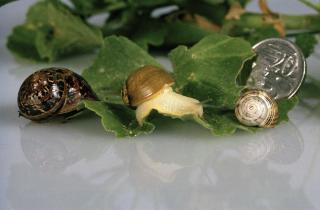What plants are affected?
Green snail attacks a wide range of plants, including most leafy vegetables, cereal crops, pasture grasses and native plants.
What do I look for?
- Green snails have an olive-green to light brown shell without any banding, and are about 15–25 mm in diameter. The body is light creamy yellow and up to 55 mm when extended.
- The green snail is intermediate in size between the common garden snail and white Italian snail.
- Green snails do not appear to be restricted to any particular soil or vegetation type. They tend to be ground dwelling and thrive in open grasslands. They can also inhabit areas of natural bush.
How does the pest survive and spread?
- During the dry summer months (November–March) the snails burrow underground and lie in a dormant state (or ‘aestivate’).
- Following autumn and winter rains the snails become active, with eggs laid in the soil from May–August and young snails appearing in early winter.
- Snails can be spread over long distances on infested machinery and containers, and in soil, plants and plant material.
What damage can this pest cause?
- The damage caused by green snail is similar to that of the common garden snail.
- Young snails feeding on surfaces of leaves often only penetrate shallowly leaving a 'windowpane effect’.
- Older snails eat holes in the leaves and may reduce them to veins only.
- During their underground summer dormancy, snails do not pose a risk to crops.
Control and Management
- Due to the presence of green snail there are conditions in place relating to the export of plants, produce and agricultural equipment from Western Australia. For properties intending to export from Western Australia, please contact our Department’s Quarantine WA section on (08) 9334 1800 for advice.
- For control advice for all other landholders, products registered for snail control in Western Australia can be used, please see links provided in the ‘See Also’ section of this webpage.
- To prevent further movement and distribution of declared pests in Western Australia, practice good biosecurity measures including cleaning any machinery and containers, and avoid moving soil, plants and plant material from infested to uninfested areas without close inspection to remove any pests.
Status in Western Australia
Green snail, Cornu apertus, is a declared organism for Western Australia under section 22 of the Biosecurity and Agriculture Management Act 2007. It is important that suspect infestations are reported.
Please see our green snail map for current distribution of this pest (also available in the ‘Document’ section of this webpage).
What do I do if I find it?
Early detection and reporting of this pest will help protect Western Australian horticultural and agricultural industries. If you find or suspect the presence of green snail make a report using MyPestGuide® Reporter or contact the Pest and Disease Information Service (PaDIS) to report this pest.
Report your observations
 | MyPestGuide® Reporter Pest and Disease Information Service |



